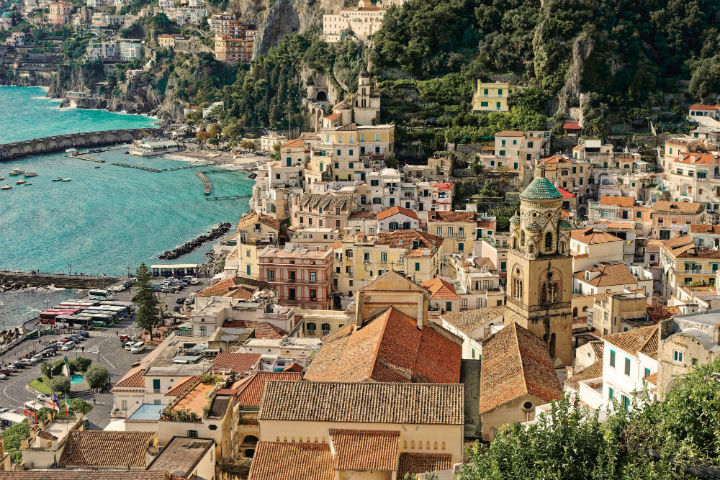Have you ever heard about Amalfi? Now you are in Naples, and you have the chance to visit it.
This tiny city near Salerno has named the section of peninsula where it stands, the Amalfi Coast – UNESCO World Heritage since 1997. Every year, it welcomes numerous tourists in its evocative narrow streets.
Since it is a tiny and lovely city with almost 5,000 residents, it may be hard to believe that Amalfi once was a maritime authority with 70,000 citizens.
The explanation for its reshaping, of residents and places worth visiting, is appalling. Everything slipped into the sea during the 1343 earthquake.
In this article, we are going to tell you more about visiting Amalfi in one day, and how to reach it from Naples and come back in the evening.
Di cosa parliamo in questo articolo
- How to travel from Naples to Amalfi
- A peaceful visit in Amalfi
- Piazza Duomo and Cattedrale di Sant’Andrea
- Chiostro del Paradiso and Sant’Andrea crypt
- Fontana di Sant’Andrea
- Fontana di Cap ‘e Ciuccio – Donkey face
- Museo della Carta
- L’Arsenale
- Torre dello Ziro
- Marina Grande beach
- Grotta dello Smeraldo
- One day in Amalfi: the walking tour we recommend
How to travel from Naples to Amalfi
Our hotel is really close to Naples’ central station. From there, it will be easy to travel to Amalfi.
From the station, you can take the train line Circumvesuviana to Sorrento. From there, you can take the SITA bus to Amalfi.
Easy peasy!
However, if you want to travel by car, you can take the motorway A3 Napoli-Salerno, take the exit Vietri sul Mare, and stay on Strada Statale 163 until you reach Amalfi.
A further option, which might seem more complicated, would be to reach Amalfi from the sea.
Since there are no direct connections from Naples to Amalfi Coast, you would need to catch the train to Salerno and, once you are there, you would need to walk from the station to the dock, in Piazza della Concordia.
At the port, you would find the Travelmar box office to buy your ticket, and then wait to embark on the ferry to Amalfi.
It could seem a long journey, however it is easier than it seems. The train ride is comfortable and it is 45 minutes long. In addition, if you would arrange a schedule, the waiting time for the ferry should be 10 minutes only.
Here you can find the ferries time schedule – effective from 1st April – from Salerno to Amalfi:


Regardless of your travelling choice to Amalfi, we can assure you that the breath-taking landscapes before your eyes will seduce you.
A peaceful visit in Amalfi
Visiting Amalfi means walking quietly and forgetting about tension and troubles.
Lose yourself in the narrow streets of the city, and discover astonishing glimpses on the sea, while observing colourful houses, and stands filled with typical souvenirs.
Let yourself go to the Mediterranean atmosphere flavoured with salt and lemons, finding yourself surrounded by the aroma of a cup of coffee, and ready for your discovery of popular sites of the city.
Piazza Duomo and Cattedrale di Sant’Andrea
Piazza Duomo is a must-visit place during your journey in Amalfi. It hosts one of the most fascinating monuments in the world: Cattedrale di Sant’Andrea.
It is known as Duomo di Amalfi. A blend of architectural styles revealing the maritime authority of the city in the 11th century:
- The sicilian Arab-Norman style prevails on the outside, especially for the two-tone masonry, the mosaics and the bell tower from the 13th century;
- The majestic bronze doors – the first of their kind in Italy – were commissioned by a local nobleman and manufactured in Syria, and then shipped to Amalfi;
- The interior is mainly Baroque, with sculptures on the altar and a few intriguing mosaics from the 12th and 13th century.
From above, climbing a 62-steps stair, its majesty appears even more striking.
The cathedral was built near a more ancient cathedral, Basilica del Crocefisso, to house the relics of Sant’Andrea Apostolo, coming from Constantinople in 1208.
These two churches – both with three naves – formed one single church with six naves, in Romantic style. However, in 1266, the naves became five, following the demolition of the left nave of the older church to build the Chiostro del Paradiso.
Duomo is open from 7:30am to 8:30pm, and it remains closed from November until March.
From 10:00am to 5:00pm, it can be accessed from the near Chiostro del Paradiso, with a €3 ticket which includes the visit to Chiostro, Duomo, Basilica del Crocefisso, and Sant’Andrea crypt.
Chiostro del Paradiso and Sant’Andrea crypt
Chiostro del Paradiso is a place in Amalfi that you cannot miss. It was built in 1266 for the graves of the most popular residents of the city.
On the left side of the Duomo’s portico, you would see the stunning cloister in Moorish style and remains of frescoes from the 13th century.
You will be looking at 120 marble columns supporting tall and narrow Arab arches which frame the central garden.
Basilica del Crocefisso can be accessed by the cloisters. It is now a museum hosting religious frescoes and artefacts, among which reliquaries from the 13th century.
From the Basilica, you can reach Chiostro di Sant’Andrea by climbing down some steps: voices become silent and the room gets darker.
This is the heart of the cathedral, in memory of Sant’Andrea, where his relics lie. The bones were brought from Constantinople to Amalfi in 1206, when the Fourth Crusade was happening – and they stayed there ever since.
A sculpture of the Saint – carved by a student of Michelangelo – keeps watch over his reliquary.
Fontana di Sant’Andrea
Reaching Piazza Duomo, we introduced you to the cathedral, since its magnificence and its colours catch the eye.
However, Fontana di Sant’Andrea represents another masterpiece: an artistic complex on the southern side of the Piazza.
It has been restored in 2018. Above, the sculpture represents the patron Saint with the cross of martyrdom, while below, little putti are represented with a mermaid, whose breasts pour water.
The Fontana is made of white marble and it is supplied by the drinking water of the Sele river.
This is a great spot to quench your thirst and rest, while exploring the city.
Fontana di Cap ‘e Ciuccio – Donkey face
Speaking of fountains, you must visit the Fontana di Cap ‘e Ciuccio, in Via Pietro Capuano, right before the Porta dell’Ospedale which has been destroyed.
The name was given by donkeys of the past which came down to drink, from Valle delle Ferriere.
In 1974, a Nativity scene was built in the fountain, made from limestone and tufa stone from Valle dei Mulini. There are figurines representing typical characters of the Nativity scene, mostly submerged in water.
We assure you this is something remarkable, it would be difficult to find something similar anywhere else in the world.
Museo della Carta
Rione Vagliendola is also a popular site in Amalfi, one of the best preserved districts, where you would appreciate the view of ancient noble residences and turreted buildings.
In this area, you will find the Museo della Carta of Amalfi, located in a former paper mill of the 13th century which seems like a cave – the oldest in Europe.
The museum kindly stores the authentic printing machines, still fully functioning, as you would see during the 30-minutes guided tour.
The tour will show you the handcrafted paper realisation and how the ancient mills work, with water from the Canneto torrent activating them.
Opening hours:
- From 1st March to 31st October: the museum is open from 10:00am to 6:30pm non-stop – everyday, including Sunday;
- From 1st November to 31st January: the museum is open from 10:00am to 4:00pm non-stop – closed on Monday;
- From 27th December to 6th January: the museum is open from 10:00am to 6:30pm non-stop – everyday, including Sunday;
- On 24th, 25th and 26th December: the museum remains closed for festivity.
Prices of the ticket start from €4.50, according to the type of visit you choose.
L’Arsenale
Have you ever heard of Arsenale della Repubblica?
It symbolises the glorious past of Amalfi as a maritime city. It was the shipyard where the naval fleet was built – defender of the Amalfi coast against the Muslim enemy.
Museo della Bussola e dell’Arte Marinara is placed in one of the naves of this imposing building, and it provides evidence of the history of the ancient Marine Republic of Amalfi.
Torre dello Ziro
Torre dello Ziro is an ancient watchtower for Saracen ships which then became a prison, with communication trenches and bastions.
In 1500, Giovanna d’Aragona, who was thought to be crazy, was imprisoned inside those walls.
A strenuous walk leads to the tower, however you will be rewarded by a breathtaking view, the appealing ruins, and the plant life enclosing the communication trenches.
Marina Grande beach
Marina Grande beach is pretty large, however you may not find a spot if you come here late.
For this reason, if you would like to enjoy the beach and a swim, you should plan your arrival in Amalfi during early morning.
The beach is crowded because of its strategic position: it is easy to access and it is close to the deck from which tours leave.
It is great for families and children, however not a good fit for people seeking tranquillity.
Grotta dello Smeraldo
Your trip to Amalfi can only come to an end if you are going to visit the Grotta dello Smeraldo.
It is four kilometres away from the west side of Amalfi. Its name is given by the colour of the water, a distinctive emerald shade.
Stalactites hang from the 24-metres-high ceiling, while stalagmites grow up to 10 metres high.
You can reach it by bus: they regularly stop at the parking above the entrance of the grotto. From there, you will take the lift or the stairs leading you to rowboats.
The peculiarity of the Grotta is an underwater Nativity scene from 1956, where every year divers from all over Italy go on a pilgrimage on the 24th December and the 6th January, and bring votive symbols.
One day in Amalfi: the walking tour we recommend
Now that you know about the places to visit during your day in Amalfi, we would like to recommend a walking tour that will help you manage your time in the city.
In the morning, you could start from Marina Grande beach and, only after a restorative dive, you could head to the old city centre by walking the promenade up until Arsenale.
Now, you should visit Museo della Bussola e dell’Arte Marinara, and then reach Piazza Duomo, by walking on via Duca Monsone.
Enjoy the view of Cattedrale di Sant’Andrea and Chiostro del Paradiso, and go shopping to the shops around Fontana di Sant’Andrea.
Right after lunch, take a walk to Valle dei Mulini, and make a stop at Museo della Carta. This would take almost two hours.
Afterwards, you could go back to the city centre, and walk to Torre dello Ziro to experience the astonishing landscape.
For dinner, you could choose one of the panoramic restaurants around the ancient rampart. Once you get back to the centre, enjoy the nightlife on the promenade.
A visit in Amalfi can only take one day, however we suggest considering it as a glimpse for a longer stay.
If you wish to experience the taste of the Amalfi Coast before your visit, book our ‘Amalfi’ room.

Insegnante di lingua e letteratura inglese per la scuola secondaria, traduttrice e correttrice di bozze. Coltivo con devozione e premura l’interesse per la cultura giapponese, e nutro tutte le mie altre creature con la stessa cura: libri, film, musica. Viaggio tanto, ma resto figlia di Partenope.

